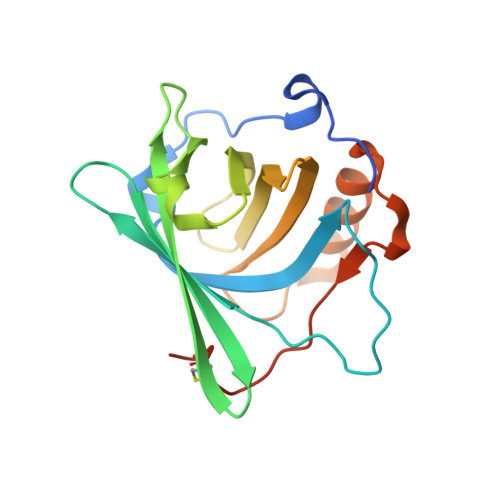High-affinity recognition of lanthanide(III) chelate complexes by a reprogrammed human lipocalin 2
Kim, H.J., Eichinger, A., Skerra, A.(2009) J Am Chem Soc 131: 3565-3576
- PubMed: 19227970
- DOI: https://doi.org/10.1021/ja806857r
- Primary Citation of Related Structures:
3DSZ, 3DTQ - PubMed Abstract:
Human lipocalin 2 (Lcn2), also known as neutrophil gelatinase-associated lipocalin (NGAL), which naturally scavenges bacterial ferric siderophores, has been engineered to specifically bind rare-earth and related metal ions as chelate complexes with [(R)-2-amino-3-(4-aminophenyl)propyl]-trans-(S,S)-cyclohexane-1,2-diaminepentaacetic acid (p-NH(2)-Bn-CHX-A''-DTPA). To this end, 12 amino acid residues in the ligand pocket of Lcn2, which is formed by four loops at the open end of an eight-stranded beta-barrel, were subjected to targeted random mutagenesis, and from the resulting library, variants with binding activity for the Me x DTPA group were selected using the method of bacterial phage display. One promising candidate was further developed in several cycles of in vitro affinity maturation using partial random mutagenesis and selection (via phage display and/or Escherichia coli colony screening) under conditions of increasing stringency. As result, an Lcn2 variant was obtained that binds Y x DTPA with a dissociation constant as low as 400 pM. The Lcn2 variant specifically recognizes the artificial ligand, as exemplified in (competitive) ELISA and real-time surface plasmon resonance analyses. DTPA-complexed Y(3+), Tb(3+), Gd(3+), and Lu(3+) are most tightly bound, comprising metal ions whose isotopes are in common use for radiotherapy and imaging. All of the Lcn2 variants are stably folded and can be functionally produced in high yield in E. coli. X-ray crystallographic analyses show that the new ligand is well-accommodated in the central cavity of the engineered lipocalin, whose fold is largely preserved, but that the mode of binding differs from the one seen with the natural ligand Fe x enterobactin. This structural study reveals analogies but also differences with respect to previously described antibody-metal chelate complexes. Notably, the functionalized side chain of DTPA protrudes from the ligand pocket of the lipocalin in such a way that its conjugates (with other haptens, for example) are recognized too. With their small sizes and robust fold based on a single polypeptide chain, the engineered Lcn2 variants provide novel modules and/or fusion partners for radionuclide-chelate capturing strategies that bear promise for medical diagnostics and therapy.
Organizational Affiliation:
Lehrstuhl für Biologische Chemie, Technische Universität München, Freising-Weihenstephan, Germany.
















